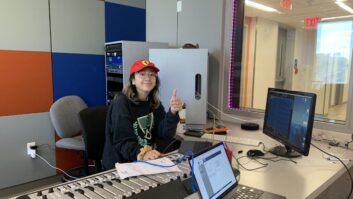(click thumbnail)The RAI editing area at the Vienna IBC during the Euro 2008 championship.ROME Public-service broadcaster Radiotelevisione Italiana (RAI) will remember summer 2008 as a particularly busy one.
Keeping RAI engineers engaged have been a series of high-profile international sporting events all taking pace in a three-month period from June to August.
The long summer began with the UEFA Euro 2008 football tournament, held jointly this year at stadiums in Switzerland and Austria, and then shifted halfway around the world to Beijing for the 2008 Summer Olympics.
Major commitment
Unlike other European broadcasters who partnered with the European Broadcasting Union (EBU) for Olympics coverage, RAI itself was responsible for providing Italians with coverage of the Games, fielding its own substantial team of engineers and journalists to give a happening of global interest the treatment it deserved.
RAI Warms up at Euro 2008VIENNA, Austria Like the Azzurri, Italian national football squad, public service broadcaster Radiotelevisione Italiana (RAI) made a major effort at the Euro 2008 tournament.
With a technical structure similar to the one set up in August for the 2008 Olympics in China, RAI sent a team of about 20 to cover Euro 2008, hosted jointly by Austria and Switzerland.
In Vienna, as in Beijing, there was an International Broadcasting Center (IBC), with reporters at the various stadiums connected to the main studio via an ISDN line and Glensound GSGC24A codecs using the G.722 algorithm.
The IBC studio prepared the contributions using an Eela Audio S130 console to mix signals arriving from the various football grounds, commentary by journalists at the IBC and any prerecorded material. The signal then went back to Rome via an ISDN line in MPEG-1 Layer II format at 128 kbps.
Prodys Pronto2 and Mayah Centauri 3001 codecs, as well as a Telos telephone hybrid, rounded out communications options in the RAI IBC studio.
RAI also had a remote facility at Casa Azzurri, the location about 30 kilometers outside of Vienna where the Italian national team stayed during the tournament.
The site had a direct connection with Rome via a Mayah Centauri IP codec, which handled both live and recorded feeds. Two journalists and two technicians were based at the Casa Azzurri site.
In Vienna, a centralized server running Netia Radio-Assist software — used by RAI to record, edit and playout audio — also was connected via IP with the main RAI server in Rome.Although most of its efforts were directed toward Rai Due television, RadioRai also connected with China to provide listeners live commentary and Olympic summaries throughout the course of the day.
In order to produce its many hours of coverage for the entire duration of the Games, RAI operated two fully equipped audio control rooms at the International Broadcasting Center (IBC) in Beijing. The second of these was a backup room, for use in the event of failure of the main control room.
Mario Accettone, technical coordinator for RadioRai, said that RAI chose a fully redundant system to guarantee the ability to cut in from the second control room immediately if the main control room had any problems. The second room was set up exactly the same as the first and could take over in real time.
A star-type connection structure was used. For the Beijing Olympics, 10 remote facilities at the various competition venues were linked back to the IBC via four-wire circuits and another 11 reporter facilities linked to the IBC via ISDN. At the IBC, RAI journalists and technicians at the IBC handled all the incoming feeds used to create each program that was transmitted back to Italy.
Nerve center
According to Accettone, the RAI journalists had various acquisition possibilities on hand, including HHB FlashMic microphones with built-in flash memory and MiniDisc systems. All reporters also carried a laptop equipped with Digigram soundcards for recording, editing with Netia Snippet and file transfer.
The content produced by the reporters in the field was used either live from Beijing or in packages sent to RAI headquarters in Rome.
At the IBC, the nerve center of the entire Olympics operation, there was an editing area where the journalists could prepare their reports just as in a normal newsroom. It housed PCs configured in exactly the same way as those used back in Rome and also provided access to a circuit of international press agencies.
RAI took to China a set up able to handle a total of 16 links, 12 of them simultaneously. The sources feed into a Soundcraft SM12 mixer with 16 inputs and 12 auxiliaries, allowing each of the 12 reporters to receive the mix-minus signal without delay problems in the return. Telephonic connections were managed by Telos hybrids.
The SM12 output sent the contribution signal to an Eela Audio S130 console, which generated the signal carried back to Italy via a 2 Mbps telcom line. This line was actually a support line that used part of the 10 Mbps circuit carrying RAI Due television coverage from Beijing.
(click thumbnail)RAI’s News Studio 1 at the Vienna IBC.Comic coverage
A Netia Radio-Assist 7 system was used for recording, editing and playout purposes, linked directly to the RAI server in Rome via IP. At the IBC, there were seven editing workstations and two playout workstations.
For all the technical and journalistic tasks, RAI sent a team of around 30 staff members to China. In some cases, the journalists in the field were responsible for both the recording and managing the connection to the IBC.
In addition to the staff responsible for sports coverage on the various RadioRai channels, a team working specifically the popular RAI Radio 2 “Catersport” program was on site. Its presenters provide “alternative,” comic coverage of sports events.
The “Catersport” team produced specific material for its Web site, as well as streaming content during the main events.













